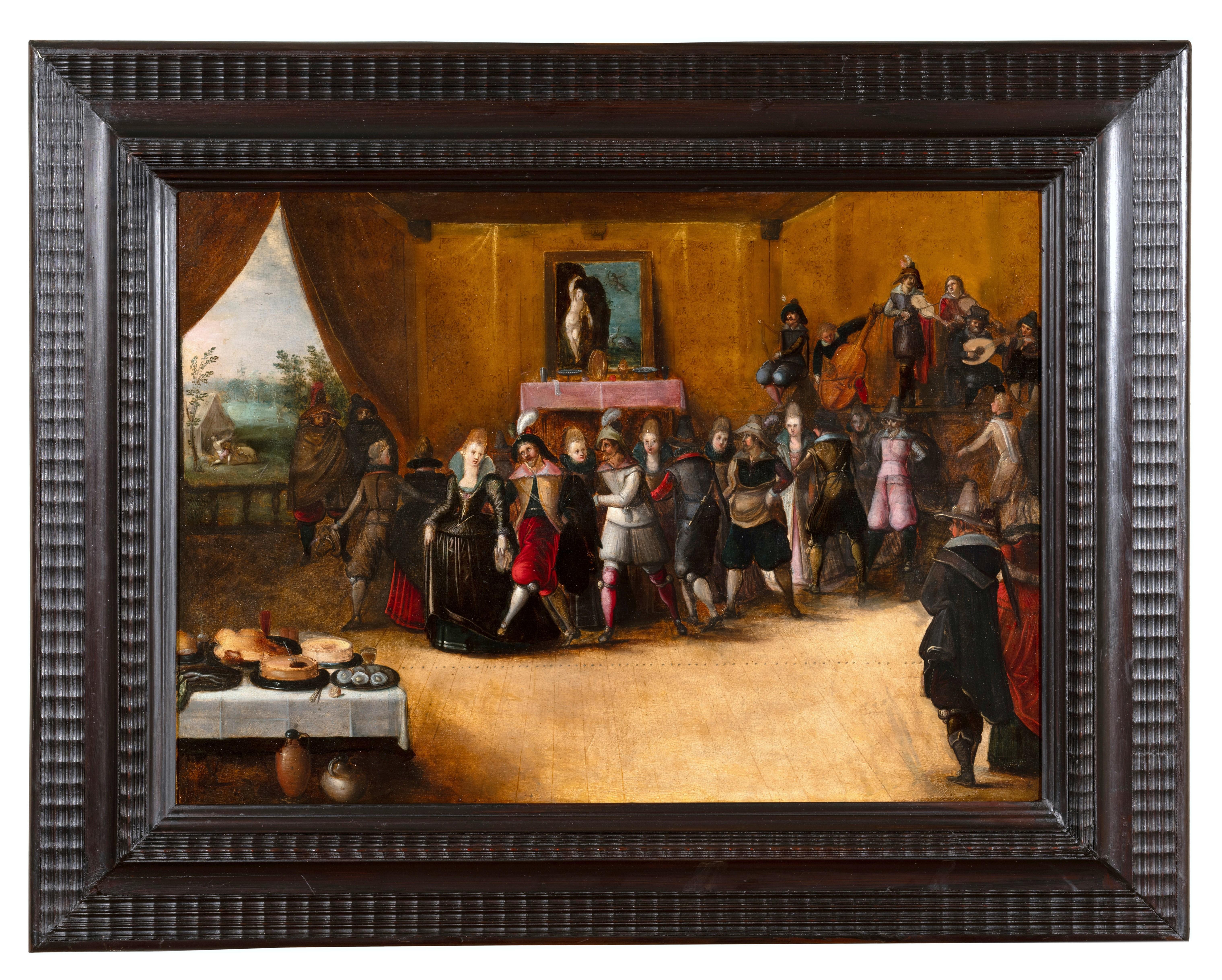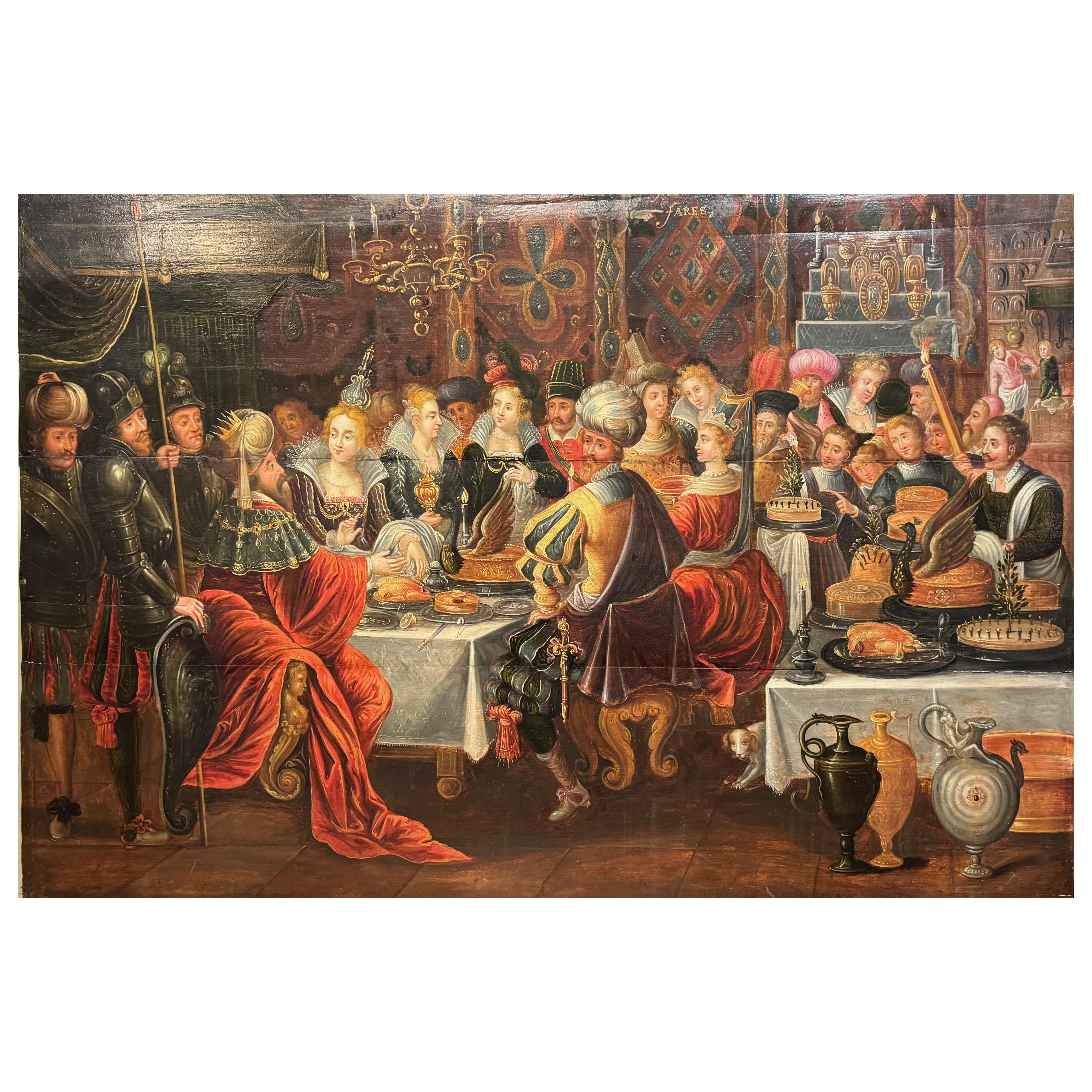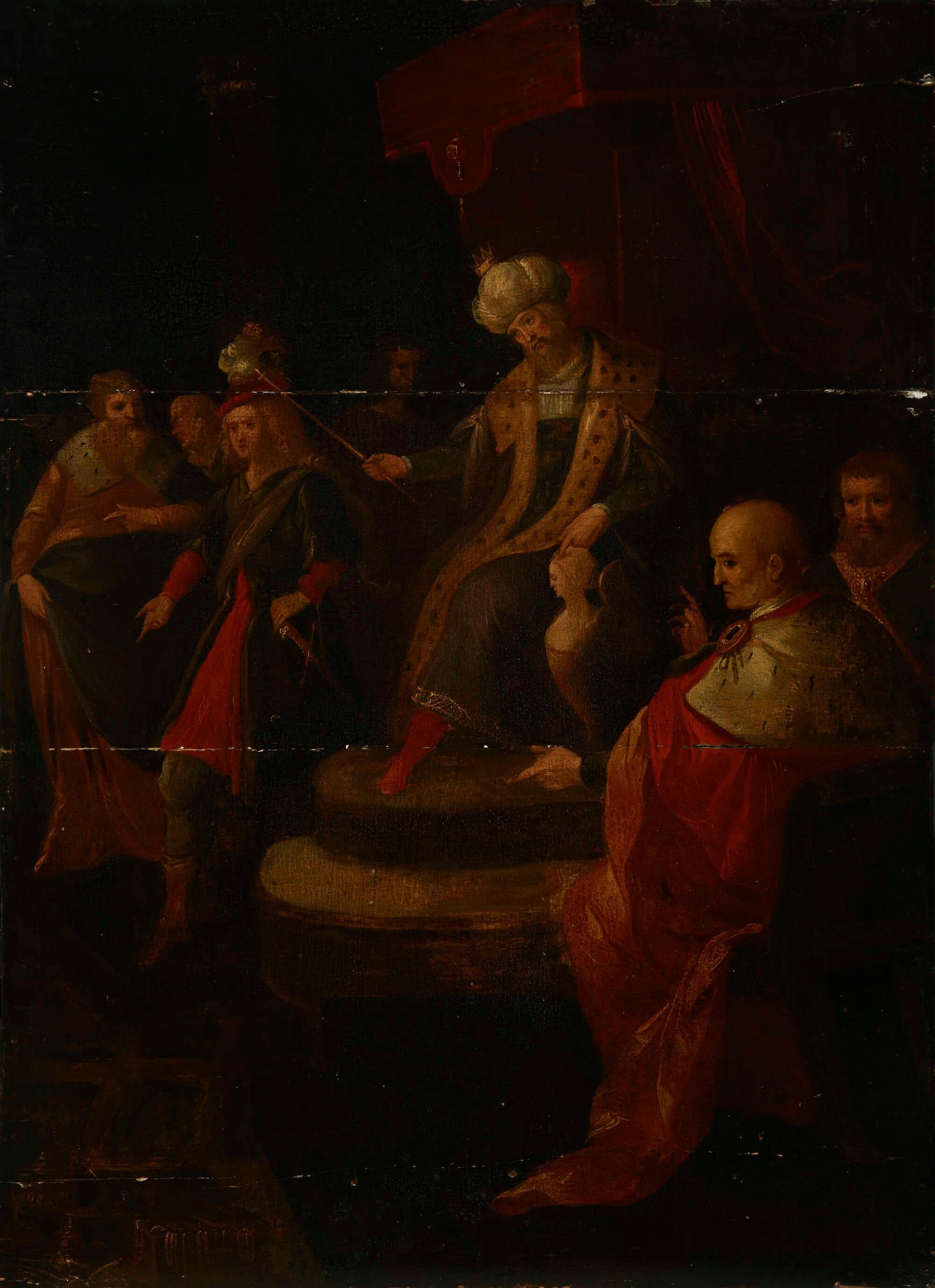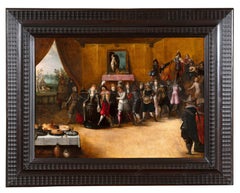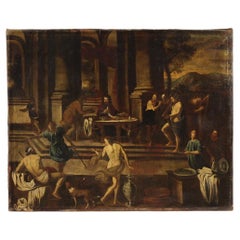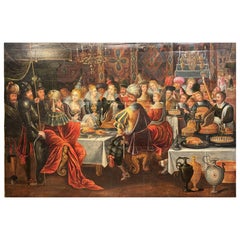Items Similar to Banquet Attrib to Van Den Hoecke Religious Oil on Table Old Master 17th Century
Want more images or videos?
Request additional images or videos from the seller
1 of 22
Banquet Attrib to Van Den Hoecke Religious Oil on Table Old Master 17th Century1585-1648
1585-1648
$15,499.71
$19,374.6320% Off
£11,482.96
£14,353.7020% Off
€13,000
€16,25020% Off
CA$21,233.82
CA$26,542.2820% Off
A$23,560.72
A$29,450.9020% Off
CHF 12,341.61
CHF 15,427.0120% Off
MX$288,917.65
MX$361,147.0720% Off
NOK 156,981.04
NOK 196,226.3020% Off
SEK 148,183.41
SEK 185,229.2620% Off
DKK 98,888.14
DKK 123,610.1720% Off
Shipping
Retrieving quote...The 1stDibs Promise:
Authenticity Guarantee,
Money-Back Guarantee,
24-Hour Cancellation
About the Item
Gaspar van den Hoecke (Antwerp, 1585 - 1648)
Herod's banquet
Early 17th century
oil on panel, with gold highlights (in the guise of Salome and in the curtains of the building in the background)
56 x 80 cm.
framed 72 x 90 cm.
Note: The painting probably dates from an original by Frans II Francken (1581 - 1642), which is shown under the number 0000344789 in the RKD.
Valuable oil painting on panel depicting King Herod and the beautiful Jewish princess Salome according to the episode taken from the Gospel of Matthew (14.3-11), which sees her as the protagonist in the story of the martyrdom of John the Baptist. The event shown is a cross between history and legend, a myth faced for centuries by artists in every field: Caravaggio in painting, Oscar Wilde in theater, Richard Strauss in music. In the artistic model, Salome, an unconscious young instrument of revenge of her mother, becomes the symbol of her most devastating and morbid lust.
On the occasion of King Herod's birthday, Salome, the attractive daughter of Herodias who loved her, performed a seductive dance for the pleasure of the diners. Her dance was so well received that Herod promised to give her whatever she wanted as a reward, even part of her reign if she wanted.
The young woman went to her mother to ask for her advice, and Herodias moved by a grudge against John the Baptist, ordered her to request the head of the Saint on a plate. Salome, an unaware victim of the wishes of her mother, becomes the interpreter of the murder of the Saint, obtained with skill and cunning, and during her banquet he presents her head as if it were a trophy on a silver tray. We see the King reacting with disdain to this situation, while the two women appear indifferent to the consequences of their gesture, standing at the other end of the table in a gold-colored dress and a wide neckline.
In the background, on the left, the event that precedes the main representation is represented in optical synchronism, that is the martyrdom and beheading of the Baptist, which takes place inside a barren prison with barred windows, in clear contrast to the situation of opulence in the first Iano.
The splendid painting, given the pictorial quality, is attributable to the workshop of the painter Gaspar van den Hoecke (1585 - 1648)), one of the greatest masters of the early Flemish Baroque in Antwerp, whose works are strongly influenced by Frans Francken's pictorial influence, artist of reference for the southern Dutch school, and with whom they have often been confused for the clear stylistic similarity. See for comparison the two works by van den Hoeche:
- Parable of Lazarus and the rich Dives'
- Il Banchetto di Baltassar, New York, Sotheby's, 24.01.08, lot 210
As we can see, his paintings, dominated by figures treated with extreme care and cloaked in dresses of large and pompous volumes, are rendered with an intense chromatic splendor and characterized by a refinement in the choice of pigments typical of the high-level Flemish school. The studied gestures of the actors and their intense mimicry are proponents of the strong narrative tension that transpires from the table and are rendered with extreme realism and definition.
The table is in excellent condition and does not show any particular restorations upon analysis of Wood's lamp. Frame in gilded wood, not coeval.
For more information, please contact us.
Painting accompanied by a certificate of photographic authenticity in accordance with the law (FIMA - CINOA)
- Attributed to:Gaspar van den Hoecke (Antwerp, 1585 - 1648) (1585 - 1648, Flemish)
- Creation Year:1585-1648
- Dimensions:Height: 28.35 in (72 cm)Width: 35.44 in (90 cm)
- Medium:
- Movement & Style:
- Period:
- Condition:
- Gallery Location:Riva del Garda, IT
- Reference Number:1stDibs: LU98817703572
About the Seller
4.9
Platinum Seller
Premium sellers with a 4.7+ rating and 24-hour response times
Established in 2017
1stDibs seller since 2018
251 sales on 1stDibs
Typical response time: <1 hour
- ShippingRetrieving quote...Shipping from: Riva del Garda, Italy
- Return Policy
Authenticity Guarantee
In the unlikely event there’s an issue with an item’s authenticity, contact us within 1 year for a full refund. DetailsMoney-Back Guarantee
If your item is not as described, is damaged in transit, or does not arrive, contact us within 7 days for a full refund. Details24-Hour Cancellation
You have a 24-hour grace period in which to reconsider your purchase, with no questions asked.Vetted Professional Sellers
Our world-class sellers must adhere to strict standards for service and quality, maintaining the integrity of our listings.Price-Match Guarantee
If you find that a seller listed the same item for a lower price elsewhere, we’ll match it.Trusted Global Delivery
Our best-in-class carrier network provides specialized shipping options worldwide, including custom delivery.More From This Seller
View AllKnight Van Douw Paint Oil on canvas Old master 17/18th Century Flemish Art Italy
By Simon Johannes van Douw (Antwerp c. 1630 - c. 1677)
Located in Riva del Garda, IT
After Simon Johannes van Douw (Antwerp c. 1630 - c. 1677)
The stop of a traveler on horseback near a post station
Oil painting on canvas
45 x 55 cm
In frame cm. 55 x 65
In this pleasant painting, depicting a knight parked near a post station, the Flemish tradition is based on a strong Italianizing sensitivity, especially by observing the setting and its peculiar brightness.
The mixture of genres and the particular style of execution make it easy to trace the authorship back to a Nordic author but active in Rome, or strongly influenced by the style in vogue in the Eternal city, between the seventeenth and eighteenth centuries: we are referring, in in particular, to a follower of the Antwerp Simon Johannes van Douw.
The chromatic elegance and refinement with which he outlines the figures are typical aspects of his painting.
The scene takes place outside a cottage, probably a post office for travelers, where a modest family divides the tasks by assisting the knights. We see a young boy who hands water to the horse before he sets off again, the father is preparing to feed him with straw and the mother who instead takes care of the little son.
The Italian reminiscences, evident in our painting, have been absorbed by many Northern European authors such as Nicolaes Berchem, Philips Wouwerman or Johannes Lingelbach, all inspired by the leader Pieter van Laer...
Category
18th Century Old Masters Paintings
Materials
Oil
$4,215 Sale Price
20% Off
Still Life Adriaenssen Paint 17th Century Oil on canvas Old master Flemish
Located in Riva del Garda, IT
Alexander (Van) Adriaenssen (Antwerp, 1587 - 1661)
Still life with oysters, fish and lobsters
Oil on canvas (67 x 110 cm - In frame 87 x 131 cm)
Expertise by Prof Massimo Pir...
Category
17th Century Old Masters Paintings
Materials
Oil
$16,739 Sale Price
20% Off
Adoration Magi Jan Van Der Straet Paint Oil on canvas Old master 16th Century
Located in Riva del Garda, IT
Jan Van der Straet, known as Giovanni Stradano (Bruges 1523 - Florence 1605), Workshop of
The Adoration of the Magi
late 16th century - early 17th century
oil painting on canvas
Mea...
Category
16th Century Old Masters Paintings
Materials
Oil
$7,315 Sale Price
20% Off
Still Life Animals Fruit De Gryef Signed Paint 17th Century Oil on canvad Art
Located in Riva del Garda, IT
Adriaen de Gryef (Leiden 1657 - Brussels 1722)
Signed ‘A Gryeff f’(ecit) - centre left
Peasant in the courtyard with still life of animals and fruit
Oil on canvas
Dimensions (cm): ...
Category
17th Century Old Masters Paintings
Materials
Oil
$7,315 Sale Price
20% Off
Announcement Waben Signed Dated 1620 17th Century Oil on table Flemish Paint
Located in Riva del Garda, IT
Jacques Waben
(Alkmaar ca. 1575-1641/1642 Hoorn)
Signed in the bottom centre and dated ‘J. Waben f./1620’.
The Announcement to the Shepherds
Oil on oak panel
103 x 63 cm
in frame 107 x 67
Provenance: Vienna Palais Dorotheum Old master painting 10.12.2015 (lot 143)
This is a spectacular depiction of the theme of the annunciation to the shepherds, set in a nocturnal atmosphere dense with photos but refined, the episode of the birth of Jesus reported in the Gospel according to Luke (Lu 2:8-15), in which an angel announces the birth of Christ to a group of shepherds.
We see the scene just as described in the Gospel passage that sets the event at night where the shepherds, intent on watching over their flock, were startled by the sudden appearance of an angel of astonishing beauty who we see here radiating a powerful golden light, while at his side a multitude of other angels from the heavenly army sing praises to God.
After exhorting them not to be afraid, he informed them that a saviour, the Messiah, had been born in Bethlehem, whom they would find wrapped in swaddling clothes in a manger, cared for by the Virgin and St Joseph.
The annunciation to the shepherds was the most depicted night scene in Flemish painting from the 15th century...
Category
17th Century Old Masters Paintings
Materials
Oil
$14,259 Sale Price
20% Off
Still Life Vanitas Noletti Paint Oil on canvas Old master 17th Century Italian
Located in Riva del Garda, IT
Francesco Noletti known as the Maltese (Malta 1611-Rome 1654) Workshop/circle of
Still life with musical instruments, toys, armour, textiles and precious objects
Oil on canvas (52 x 78 cm. - in frame 71 x 102)
This painting, of beautiful scenic effect, depicts a still life composed of a rich display of precious objects, arranged with an apparent disorder, one part on a table and the other on the floor, all theatrically behind a hanging drape from which tassels swing.
Among the objects, our author has reproduced we can see parts of a parade armour with gold borders, jugs and plates...
Category
17th Century Old Masters Paintings
Materials
Oil
$9,547 Sale Price
20% Off
You May Also Like
Attributed à H. Francken II, 17th c. Anwerp - The prodigal son among courtesans
Located in PARIS, FR
The Prodigal Son Among Courtesans
Attributed to Hieronymus Francken II (Antwerp 1578-1623)
Early 17th century Antwerp school
Oil on oak panel,
Dimensions: H. 52.5 cm (20.67 in), W. 74 cm (29.14 in)
Flemish-style moulded wood frame
Frame: h. 78 cm (h. 30.70 in.), w. 100 cm (39.37 in.)
At first glance, this festive and joyful painting depicts a group of elegantly dressed people dancing to the sound of an orchestra in a richly decorated interior with a wide opening onto a rural exterior. However, the real theme is cleverly concealed by the painter and is only discernible through the artifice of a small scene in the background where we see a half-naked man, in the company of the pigs next to a makeshift shelter.
In fact, beyond the pleasant and apparently superficial character of the painting, it is a subject taken from the parable of the prodigal son in the Gospel. The illustrated episode is the prodigal son among courtesans.
Even if the viewer's attention is drawn to the central couple (prodigal son embracing a pretty courtesan) doing the dance steps, the artist takes care in a narrative approach of all the groups and ancillary scenes in order to create a rich and varied composition. Thus the musicians seated on a raised platform are depicted with great skill, their faces animated, their clothes abundantly varied.
The theme of music, which has always been associated with that of sensuality and physical love, helps to exacerbate licentious pleasures.
The merry company dances "Spanish pavane", a slow court dance from the sixteenth century, danced close to the ground by couples arranged in a procession, which was probably introduced to the south of the Netherlands around 1600 during the governance of Albrecht VII and the daughter of the King of Spain Isabella Clara Eugenia in Brussels.
The interior of the house is also carefully elaborated, the embossed leather dyes on the walls, the middle sideboard (typical in Francken interiors), where the rich gold and silver crockery is placed in front of the painting "Andromeda chained to the rock and Perseus arriving to rescue her". The inclusion of a contemporary and probably extant pictorial work is also one of the characteristics of the Francken family, among them Frans Francken the Younger...
Category
Early 17th Century Old Masters Interior Paintings
Materials
Oak, Oil
17th century Oil on Canvas Italian Biblical Painting Herod's Banquet, 1650
Located in Vicoforte, Piedmont
Antique Italian painting from the mid-17th century. Oil on canvas artwork, first canvas, depicting a biblical episode of great charm, Herod's banquet, of excellent pictorial quality....
Category
Antique 1650s Italian Paintings
Materials
Canvas
The Feast of Balthazar, Frans FRANKEN II and workshop, 17th c.
By Frans Francken II
Located in PARIS, FR
Large oil on oak panel (105 x 72 cm), portraying ‘The Feast of Balthazar’.
Attributed to Frans Franken II and his workshop.
The workshops of Antwerp spread throughout Europe, produci...
Category
Antique 17th Century Dutch Other Paintings
Materials
Wood
Huge 1700's Dutch Old Master Oil Painting Elegant Court Figures Musical Soiree
Located in Cirencester, Gloucestershire
Artist/ School: Dutch School, early 1700's.
Title: Elegant Court Figures at a Musical Soiree.
Medium: oil painting on canvas, unframed.
Size: painting: 40 x 49.5 inches
Provenanc...
Category
Early 18th Century Figurative Paintings
Materials
Canvas, Oil
Fine 17th Century Dutch Old Master Oil on Wood Panel Ester before Ahasuerus
Located in Cirencester, Gloucestershire
Ester before Ahasuerus
Dutch School, 17th century
circle of Rembrandt
oil painting on wooden panel, unframed
panel: 28 x 20 inches
provenance: private collection, London
condition: very good and sound condition for its age though there are old panel splits evident and minor, but stable, paint loss in those areas, as shown in the photos.
The subject of ‘Ester before Ahasuerus’ was narrated by the Bible’s Book of Ester (V: 2-34). Here, the Persian King...
Category
17th Century Old Masters Figurative Paintings
Materials
Oil
Baroque Dutch painter - Late 18th century figure painting - Inn Interior - Panel
Located in Varmo, IT
Dutch painter (18th-19th century) - The spanking.
60 x 99 cm without frame, 67 x 106 cm with frame.
Antique oil painting on panel, without frame (not signed).
Condition report: Wo...
Category
Late 18th Century Old Masters Figurative Paintings
Materials
Oil, Panel
$2,384 Sale Price
28% Off
More Ways To Browse
Old Painting Oil On Panel
Dutch Paintings Old Master
Old Master Flemish
Diner Art
Music Notes Paint
Dutch Oil Paintings 17th Century
Old Master Painting Flemish
Religious Paintings On Wood
Antique Religious Oil Paintings
Old Masters Paintings In Gold Frames
Old Religious Painting
Dutch Master Paintings 17th Century
Religious Art Panels
Wanted Antique Paintings
John Law
Antique Jewish Art
Diners Art Painting
Antique Wishing Well
